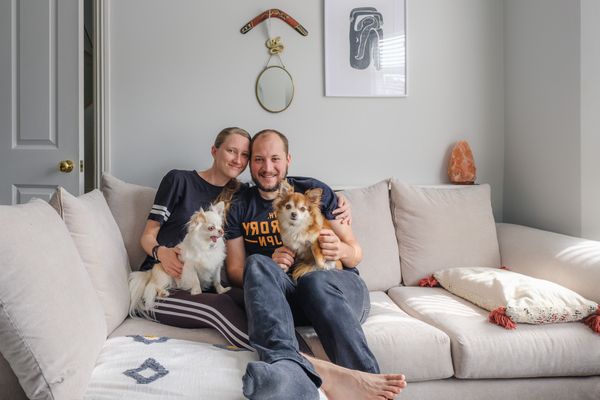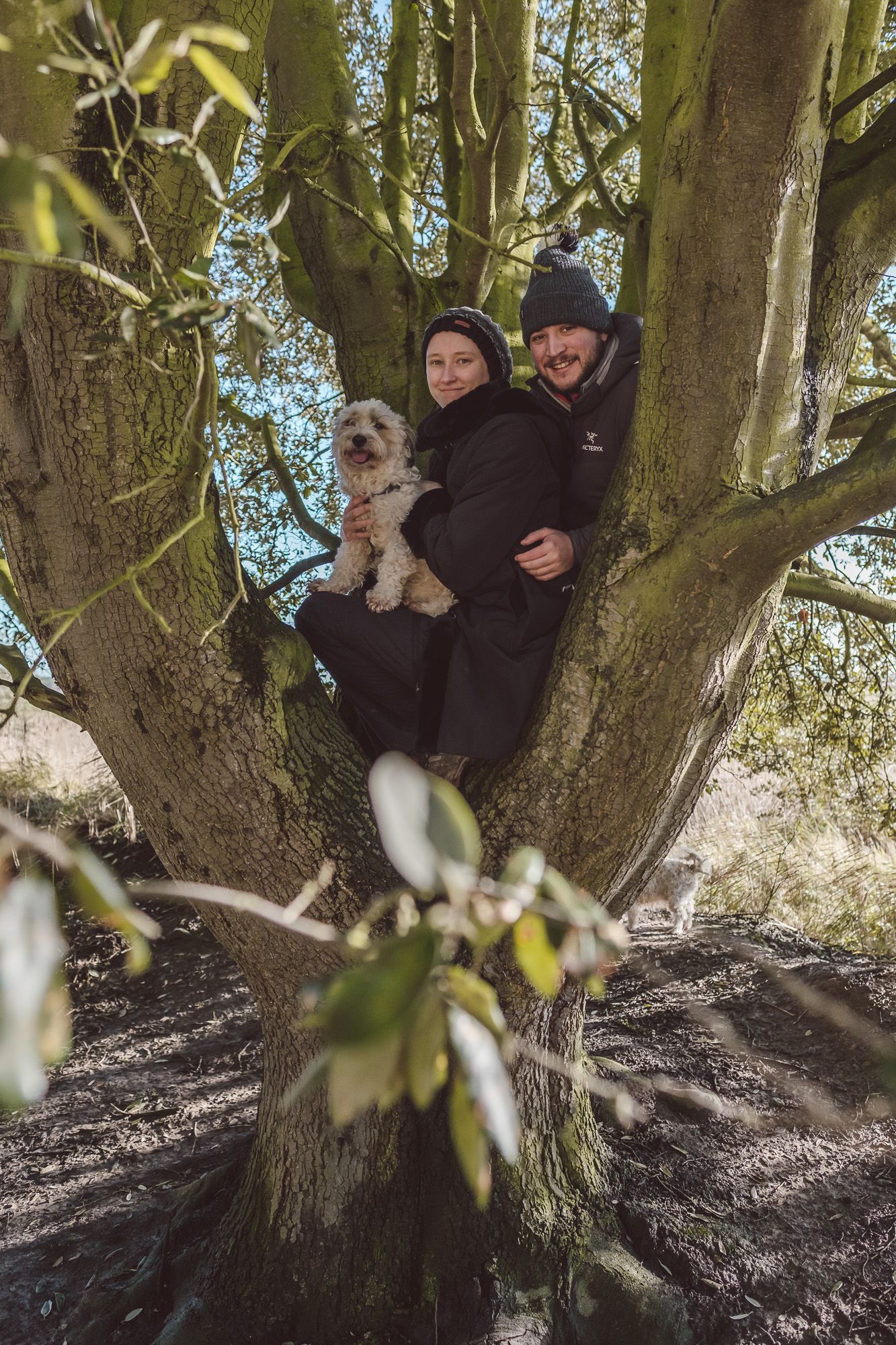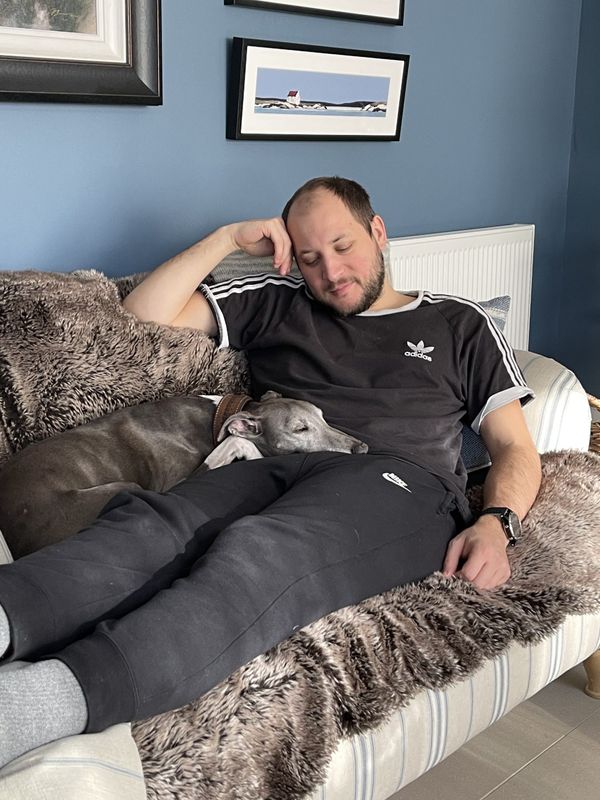In 2021 we’re heading into our fourth consecutive year of full-time housesitting, with over 60 housesits under our belts.
In the current climate, we feel very fortunate that we secured a repeat housesitting assignment for a homeowner who has become a friend, as we’ve taken care of her countryside cottage in Norfolk plus her three adorable dogs annually since we began our journey in 2018. One evening, on one of the last days of our sit this year, we were curled up on the sofa watching Netflix with all three pups snuggled up under a blanket with us. Chris turned to me and said
‘This is what I’ve missed lately – having cuddles at home with dogs, and having them feel so settled with us.’

The Covid pandemic put our usual full-time housesitting on hold, and while we’d managed to satisfy our cravings for furry cuddles with dog walking in line with government guidelines, we realised that it had been months since we’d simply relaxed at home with pets on our laps.
Coming to the end of that six week sit, we were sad to say goodbye to Inca, Puff and Winnie once again. It got me thinking about the nuances of each housesit, how each one is different, and how our experience can largely depend on the length of our stay. We rarely take on super long housesits – in fact this six week housesit in Norfolk was our longest sit to date. Throughout our 60+ housesits over the past three years, here’s what we’ve come to discover about shorter housesits vs long ones:
Short housesits
Of course everyone has their own definition of what is a ‘long’ or ‘short’ housesit, but from our experience we consider 10 days or less to be a ‘short’ housesit. It takes us a couple of days to really settle into a routine and get to know how things work in a house, where everything is, and how the pets behave. We get a few days of relaxed housesitting where we know the drill, but then before we know it we’re completing our final clean and we’re off again! Our shortest housesit to date was just over 24 hours, caring for two dogs and a domesticated hen at a house in Eastbourne, while their owner travelled to London for a concert and a night staying in the city.
The pros of a short housesit:
You see a lot of places
Our top pro of short housesits is that it’s a great way to travel to different areas in a short space of time. If you stay organised and line up your dates, while considering your arrival and departure times for each housesit, it’s possible to squeeze three housesits into a week, back-to-back. As long as you don’t mind travelling a lot over those days, it’s awesome to explore so many different places.

You can quickly gain pet care experience
If you’re looking to branch out from just caring for cats and dogs, short sits are fantastic for finding a variety of pets to care for over a short space of time. Five days caring for tortoises might be the perfect introduction to reptile care, or a weekend with horses, without worrying too much about the long-term responsibilities.
They’re a good stopgap
Sometimes we’ll have a week-long gap between one housesit ending and another beginning. On occasion we take this as an opportunity to have a mini break just the two of us, with no responsibilities to homeowners, and we find places to stay in between the two housesit locations where we can explore without the tie of finding dog friendly places or having cats to rush home to. Other times we like to browse housesitting websites and update our availability to book in last-minute housesits in this time, if we’re already travelling that way for our next assignment. Not only does it give us another sit under our belts, with new experience, but it also feels great to help out a homeowner on our way!
If the housesit is problematic… You’re not there for long!
Sometimes we arrive at a housesit and realise that it’s just not for us. From not doing our due diligence before we arrive, to homeowners forgetting to mention vital information, we’ve experienced it all during our travels! In these moments when we get a sudden sinking feeling in our guts, we take a deep breath and resolve that it’s just for a few days…!
The cons of a short housesit
You don’t make life-long pals
One of the true joys of housesitting is feeling like we’re really bonding with the pets. We love it when dogs follow us around the house, or cats choose to curl up on our laps. When you’re housesitting for just a few days, it’s less likely that the pets will grow to love you and get attached – not 100% unheard of, just less likely – and of course there’s always the chance that you’ll be invited back to sit again!

Staying organised
Oh gosh, if only our friends knew the sheer amount of ADMIN it takes to live and housesit nomadically! We made our own shared digital calendar so we can stay on top of housesit plans, colour coding each housesit and referring to it each time we’re planning our next moves. It can get more complicated to plan short sits all in a row – I have to save each homeowner’s name in my phone with their location as their surname, and an emoji of what pets they have, to help me out when I receive a call or text! To help you stay organised like us, you can download a template of our calendar here!
You never truly settle in
For a housesit shorter than a week we rarely bother unpacking our bags. The truth is, once you’ve unpacked everything and used various belongings, before you know it you’re packing it all up again and wondering how the hell you lost your phone charger in just three days. You’re less used to the space, and you don’t have time to get used to it, so you don’t have those second-nature, ‘makes sense in my mind’ spots that you associate with various activities. You know that armchair you always read in, the one you keep your book next to? None of that on short sits – you’ll read there once, put the book on the arm, forget about it, and spend a frantic twenty minutes on your last day running all over the house looking for it. We once took over from a housesitter who’d been at the house for three days before our arrival – she left her reading glasses on the windowsill, a bag of shoes on the porch, an apron in the kitchen and socks in the bedroom. See what I mean?
In the same way that we don’t unpack, we also tend to keep ourselves to only a few rooms in the house to save us from deep cleaning the entire house after a four day stay (and this reduces the amount of hiding spots that misplaced belongings could be in…) This is fine short term, but it doesn’t really feel like home.
Constantly travelling from place to place
We’re glad we have our own transport, in the shape of our little Ford Fiesta, to get us from sit to sit. However, if you’re constantly on the move, by default you’ll use more petrol, and if you rely on public transport to get to your housesits the costs can add up quickly. We’re yet to have a homeowner offer to pay us for travel expenses and we never expect them to – it’s just something extra to factor in when considering taking on the housesit. We always weigh up whether the travel distance is worth the length of the sit before we apply, as it can get tiring and mentally draining. There are exceptions – like the time we drove from the Ashdown Forest to Bristol for a two day sit, because we just HAD to look after five adorable Dachshund siblings. We still talk about how adorable that sit was. Worth every mile travelled.
Long housesits
After a bit of consideration, we’d define a ‘long’ housesit as any time over three weeks. Our longest housesit to date is six weeks – the one we just completed in Norfolk. We felt comfortable taking on such a long housesit as we’ve built up a rapport with the homeowner, and not only do we know what our responsibilities are, but we LOVE the housesit. Caring for her three rescue terriers is an absolute joy, and a housesitting highlight every year as we settle back into the routine.

The pros of a long housesit:
It feels like home
Arriving at a housesit and knowing we’ll be there for at least a few weeks feels completely different to short sits. Over the course of the sit, the house becomes a home and we can really relax into our surroundings. If you work remotely from home (in normal times, not just during the pandemic) then long housesits allow you to just be in one place without having to worry about planning your movements. It’s especially great if the sit is for an aloof cat that just requires feeding and a warm lap to sleep on, or a housesit with no pets at all where your time is truly your own.
Slow living in a country / city you love
Fancy living your best life in New York for three months, without paying rent or bills? Spending your days exploring the city, walking a dog through Central Park, looking out over Manhattan from the window of your apartment? Of course you do. Long housesits not only give you the opportunity to feel at home, but that feeling of home can be in a totally new city, new county, new country! If at any point in your life someone asks you if you’ve lived abroad, you can say yes! You can truly live like a local when you settle into a long sit, and if you want to explore Reykjavik, Berlin, Mexico City, really soaking up the culture and staying for an extended amount of time – a longer housesit gives you the chance to do so and makes sometimes expensive flights worth the cost. Just make sure you’re sitting for adventure-friendly pets, to avoid wistfully staring out the window on a beautiful new city with a high-maintenance pet at your side.

Building up relationships with owner and pets
Something that we never really factored in when beginning our housesitting journey was how many relationships we’ll build with people all over the UK, and the world. We love it when homeowners get back in touch to offer us another stay at their home, as it always feels to a degree like returning home. There’s no worrying about hidden horrors – we know the pets and home well and homeowners trusting us with their home for a long period of time feels really special. Even when homeowners message us just to update us on their pets, we love it, and we still chat to many past homeowners via Instagram or WhatsApp. It’s so special to form a bond with different pets too – at one repeat booking in Hove, sweet Saluki Jem always greets us upon arrival with a big happy grin and an excitable wagging tail. We love that he remembers us, and it’s great that the homeowners can see the bond we’ve formed with their pets.
Getting into a routine
This could be a pro or a con depending on the type of person you are, but for those times when we just need some stability (like during a global pandemic…) long sits provide some much needed consistency and we enjoy relaxing into a daily routine. Sometimes pets will have a strict regime where they eat and exercise at specific times of day, and other times it’ll be up to us to shape our own routine. We tend to prefer the latter, as it really starts to feel like our home, our lives, our way.
The cons of a long housesit:
Getting stuck
Thankfully over the past three years we’ve never felt SO uncomfortable at a housesit that we’ve had to leave – though we’ve heard horror stories from other sitters. The risk you take with a long housesit, especially if you haven’t sat there before, is that there might be hidden surprises or it just might not be all it’s cracked up to be on the listing. We’ve dealt with more than a few issues over our time, and it’s made worse by knowing you’ve still got two or more weeks to go. It’s one of the reasons we’re so thorough with our questions in the stages before confirming, as we don’t enjoy unexpected surprises on a sit! You can download our question list for homeowners here.
You might be asked to cover bills or contribute to rent
On sites like Trusted Housesitters, it’s against the terms of service to ask for money from your housesitter – the arrangement is one of mutual benefit and is agreed upon before confirming a sitter. However, we’ve seen countless listings for longer sits where the homeowners state that sitters must contribute to the running costs of the house – sometimes this is hundreds of pounds. We’re quite undecided on whether this is fair or not – after all, the homeowner is saving what is oftentimes hundreds upon hundreds of pounds just by not having to put their pets in kennels / catteries / stables / pay someone to pop in on their goldfish. Overall, if the homeowner has declared it in their listing we say it’s up to the individual sitter to decide whether that arrangement works for them. If it doesn’t, move on.
Boredom for those with wanderlust
Depending on your day-to-day life, the possibility of becoming bored on a long sit is real. Early on in our journey we confirmed a three week housesit on the edge of the New Forest, and were excited thinking of all the beautiful walks we’d be going on with the two dogs. Upon arrival the homeowners told us that they only walked the dogs for ten minutes around the block each day, plus the dogs didn’t like being left alone, and our hearts sank. After a few days we’d walked around the residential streets every which way we could, and while we managed to entertain ourselves with hobbies at home, we were itching to get out more. It’s experiences like this that have shaped our decision-making strategies for the past three years – we always think about what our daily life at a housesit will look like – especially if we know we’ll be there for several weeks. We still left a positive review for the sit, even though there were quite a few things they didn’t disclose until we arrived, because we understood that the situation might’ve suited someone else. Just not us.

More responsibilities
Obviously if you’re at a housesit for a week vs a month, your list of on-sit responsibilities is going to differ wildly. If the homeowner is away for an extended period of time, they may ask you to take on some jobs that wouldn’t need tending to if they were only out of the house for a few days. From our experience, these could include anything from watering house plants and checking cats for ticks, to bigger jobs like mowing the lawn or taking pets for vet check ups. A homeowner should always disclose these extra responsibilities before the sit is confirmed, however it’s always good to ask them if they expect anything extra from you just in case it’s slipped their mind.
More chance of things going wrong
A strange phenomenon of staying at one sit for a longer period of time is that there seems to be more chance of things going wrong. We can’t quite figure this one out, because if you take on six different one-week sits there should be the same chance of things going awry as if you just took on one six-week long sit, right?? Somehow, we find the longer we stay somewhere the chance of things going wrong increases – from pets getting sick, to attic boilers leaking through the bedroom ceiling and destroying our property (Yes, this happened to us. Yes, it was horrific). We’re not sure whether it has to do with getting used to a new space over and over again, whether we relax and get complacent, or whether it’s just a coincidence, but we seem to have worse luck during longer housesits.
If you found this post helpful, please support our blog by donating as little as £1 to our running costs! Thank-you!







